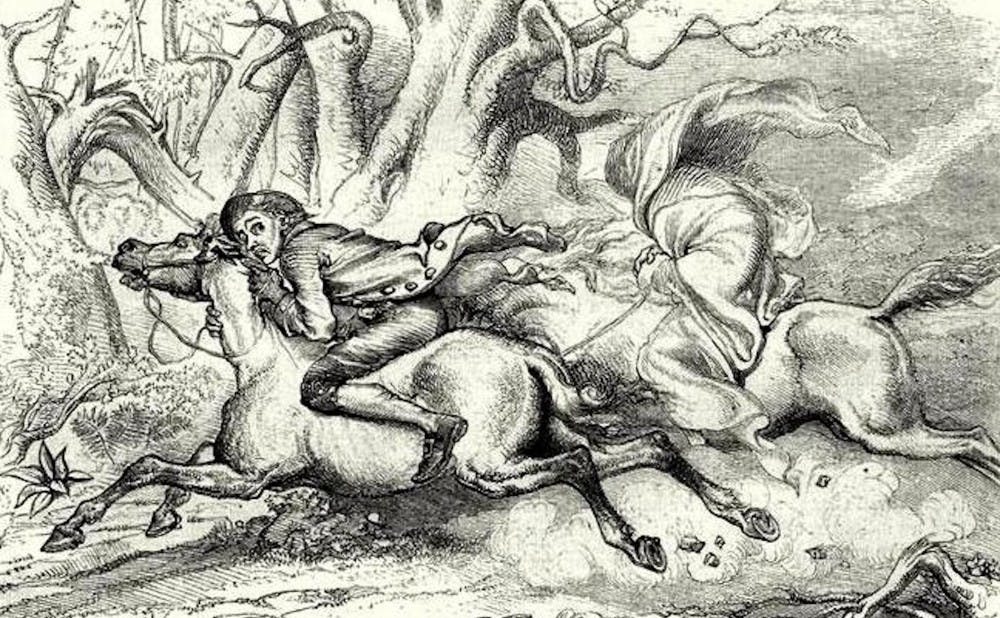During the Halloween season, we are accustomed to being bombarded with adaptations of myths, whether through verbal communication, literature or on screen. However, we rarely see these interpretations transformed into a ballet. Celebrating its 20th anniversary, Carolina Ballet is presenting a new story ballet this month called “The Legend of Sleepy Hollow,” along with two smaller ballets. The creation of new ballets, as opposed to re-staging an older work, is normally an arduous task that more often than not produces disappointing results. In the past, the works of Carolina Ballet have followed this pattern. But, due to the changes that Carolina Ballet has experienced recently, the second performance of the 2017-2018 season indicates that the company is moving in the right direction.
The focal point of the evening, “The Legend of Sleepy Hollow” follows a shy schoolmaster, Ichabod Crane, who falls in love with the daughter of a rich farmer, Katrina Van Tassel. He plans to marry her before realizing that there is another villager, Abraham Van Brunt, who also wishes to propose to Katrina. After Katrina accepts Abraham’s proposal, Ichabod travels home disheartened and comes upon a cloaked rider with his head on his saddle. The cloaked rider throws the head at Ichabod, who is then never heard from again.
The new ballet demonstrates the creativity of choreographer Zalman Raffael — who was recently appointed co-artistic director with founding director Robert Weiss — and how Carolina Ballet is improving with age. The choice in music was a particularly clever decision: multiple times, the score of “Carnival of the Animals,” which was originally written with humorous intent, accurately showcases the emotions of the characters in Raffael’s ballet. In one instance, Ichabod teaches a group of young girls in the schoolhouse to music from the “Hens and Roosters” section of “Carnival of the Animals,” and the score aptly demonstrates the fear and confusion of the girls and their teacher. The music’s use of accented notes at the end of phrases align perfectly with the unexplainable events that occur during the scene, such as books falling off the shelf without any applied force.
Raffael does an excellent job in capturing an early American setting, a time period associated with a large portion of our Halloween myths and superstitions. In addition to the American myth of the Headless Horseman, Raffael successfully captures this ambience through costuming, which is historically accurate to the time period, and large corps de ballet numbers, which are reminiscent of early farming America.
In scenes with the corps de ballet, Raffael’s lack of originality becomes apparent as he follows the stereotypical format of all other story ballets. Large corps de ballet scenes usually follow a similar pattern of having a couple celebrating their love by leading a group dance, only to be affected by another factor. This is the case in one of Raffael’s concluding numbers, in which the female protagonist, Katrina Van Tessel, decides to marry a man named Abraham and is disturbed by Ichabod, who also wished to marry Katrina. They all stand in the center as they dispute while the group dances around them, a normal occurrence in most story ballets. Although his overall layout of the corps number is predictable, his steps are refreshing and innovative as he does not repeat phrases like a typical corps dance does.
With these new improvements, it is evident that the company has built on strong foundations made, in particular, by Weiss and a very influential dancer, Margaret Severin-Hansen. An informal poll of Carolina Ballet’s audience revealed that Severin-Hansen was their favorite dancer to watch — and rightfully so. In this particular performance, she danced the memory of the mourning Scholar’s lover in Robert Weiss’s new ballet based on Edgar Allen Poe’s poem, “The Raven.” The dramatic pull between the controlling Raven and the Scholar creates suspense as they throw Severin-Hansen between one another to showcase the Scholar’s longing for her. Severin-Hansen has always possessed the quality of floating across stage and creating suspense through her movements through effective musical phrasing, and this performance was no exception. Weiss’s choreography aids Severin-Hansen in creating this dramatic pull between the Raven and the Scholar and overall accomplishes the sense of uncontrollable mourning of the Scholar. Like Raffael, Weiss’s choice in music displays a sense of sadness through dramatic string movements.
The Carolina Ballet’s ambitious lineup for the rest of the season, which includes several major story ballet productions, makes me wonder if each performance will be as enjoyable as “The Legend of Sleepy Hollow.” But with the combination of new talent and old, Carolina Ballet looks better than it ever has before.
Get The Chronicle straight to your inbox
Sign up for our weekly newsletter. Cancel at any time.

